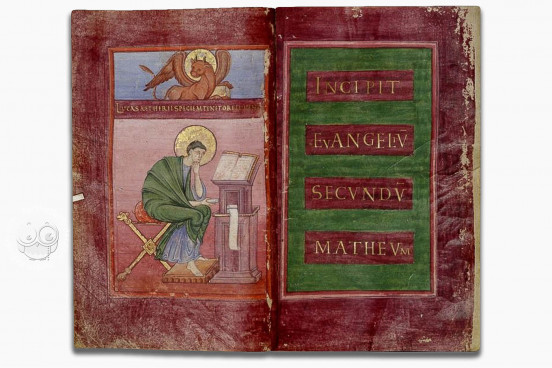The Strahov Evangeliary is one of the greatest works of Ottonian manuscript illumination. It features four full-page illuminations of the four Evangelists painted by the great Ottonian illuminator, the Master of the Gregory Register, the artist of a number of exquisite manuscripts. The tenth-century illuminations were added in Trier over a century after the text was written in Tours and feature monumental, detailed figures on purple-dyed pages.
The entire manuscript is written in a Caroline Roman Uncial with sections delineated by framed gilt lettering on purple ground. It is bound in a jeweled velvet cover of late-medieval Czech origin featuring a central crucifixion in high relief. With its Carolingian text, Ottonian illumination, and Czech jeweled cover, the magnificent Strahov Evangeliary is a priceless treasure of medieval manuscript production.
An Exceptional Evangeliary from Two Great Scriptoria
The main text of the Strahov Evangeliary was written at the monastery of Tours (France) in the Carolingian Empire around the year 860. The script is a Caroline Roman Uncial written in black-brown ink in long lines of twenty-four rows with chapter titles in gold on framed purple bands.
Over a century later, when the book was in Trier (Germany) in the Ottonian Empire, four illuminated purple-dyed folios were added. These featured, on the left, an evangelist portrait by the Master of the Gregory Register and, on the right, an exquisitely written title page with gold Uncial lettering on purple bands.
Exquisite Ottonian Book Illumination
While the body of the evangeliary's text is Carolingian, the four figural illuminations and title pages are early Ottonian and painted by an artist called the Master of the Gregory Register.
This artist worked in the scriptorium at Trier and produced artwork for several manuscripts including Sainte-Chapelle Gospel Book (Paris, Bibliothèque Nationale, Lat. 8851), the Codex Egberti (Trier, Statbibliotek Trier, Hs 24), and the work for which he is named, the Registrum Gregorii Trier, Stadtbibliothek Trier, Hs 171/1626).
His work is characterized by large, statuesque figures. The stylized drapery suggests a volumetric body beneath through the use of tonal shading. The heads of the figures tend to be proportionally small, however, the faces are rendered especially well suggesting portraiture.
A Treasure of the Czech Republic
The Strahov Evangeliary has been in Prague since 1143 when it was part of the foundational library of the Premonstratensian community that moved from Steinfeld in the Rhineland and established the religious house on Strahov, or Mount Zion, in Prague in the mid-twelfth century.
The manuscript survived a great fire in 1258 and during the Hussite Wars in the fifteenth century. It was here that the book was rebound in the early sixteenth century in its current jeweled cover.
The red velvet binding dates to around 1500 and is of Czech origin. It features cut crystals, Roman enamel plaques, silver medallions of Evangelist symbols, and Romanesque and Baroque gilded bronze reliefs affixed directly to the cover in a symmetrical arrangement.
The central sculptural reliefs form a composite Crucifixion scene with a crucifix flanked by Mary to the left and John to the right. Two bishops are affixed among the set crystals. Set into filigree frames between pairs of Roman enamels are two additional reliefs: Christ Enthroned above and the Madonna and Child below. Silvered iron attachments protect the corners and two filigree clasps secure the covers.
We have 1 facsimile edition of the manuscript "Strahov Evangeliary": Evangelistarium Strahoviense facsimile edition, published by Tempus Libri, 2012
Request Info / Price
